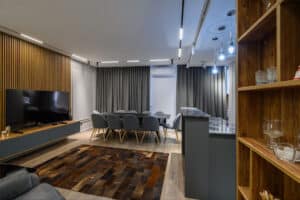
As we age, our eyesight tends to deteriorate, making it difficult to see clearly, particularly in dimly lit environments. Fortunately, advancements in lighting technology have made it possible to improve the quality of life for seniors through LED lighting. LED lights are energy-efficient, long-lasting, and emit bright and clear light that closely mimics natural sunlight. As a result, they’re an ideal option for seniors who need adequate lighting to perform daily tasks, maintain their independence, and reduce the risk of falls. In this blog post, we’ll explore the benefits of LED lighting for seniors and why it’s worth considering as an essential element in creating a safe and comfortable living environment for older adults.
Why Is LED Lighting Good for Seniors?
More Brightness
As people age, their eyesight tends to deteriorate, making it difficult to see clearly, especially in poorly lit environments. The eye’s lens becomes more transparent with age, and aging eyes require 75% more light than those of a 25-year-old. Seniors experience increased sensitivity to glare and find it hard to adapt quickly to changes in light levels, such as when moving from a dark room to a bright room. Aging also causes physiological changes that decrease visual acuity and color discrimination while enhancing sensitivity to glare. These changes can lead to conditions such as macular degeneration, glaucoma, and cataracts. Vision loss is a significant cause of falls, fractures, and other injuries among seniors. To help avoid these issues, LED lighting fixtures can provide an even level of lighting.
Health Advantages
LED lighting is an ideal choice for healthcare and senior living facilities due to its energy efficiency and low power consumption. Additionally, it provides numerous health benefits, such as preventing vision loss and eye disorders, as it only produces light in the visible range with no damaging UV or infrared radiation. LED lighting also has a high color rendering index (CRI), which is helpful for seniors as the lens of the eye gradually yellows with age, making it difficult to differentiate between colors like blue, blue-green, and violet. LEDs with high CRI can aid in the visibility of actual colors compared to other light sources.
Longevity and Versatility
You can find a LED lighting company that offers fixtures that have a lifespan of up to 50,000 operating hours, which is longer than that of standard light bulbs. This means that seniors or personnel at home will not have to frequently change the bulbs. LED bulbs are small and versatile, making them ideal for various applications, particularly in assisted living homes where sufficient task lighting is crucial for seniors. They can be positioned to provide maximum focus on specific tasks, such as reading, knitting, or eating. Installing LED bulbs under bed rails or along hallways can also help illuminate areas and reduce the risk of accidents. Additionally, using LED bulbs in areas like kitchens and bathrooms can minimize potentially dangerous situations.
Better Than Fluorescent
Most assisted living facilities and healthcare institutions use fluorescent lighting systems in their hallways and rooms, which are known to have several drawbacks and potential health hazards. These lighting systems produce sporadic light that may result in flickers, which can cause drowsiness, headaches, and eyestrain. Furthermore, fluorescent bulbs contain mercury, a dangerous pollutant that can cause harm to the environment and human health. Since some seniors are sensitive to light, the color emitted by fluorescent lamps may change over time, affecting depth perception and making it a safety concern for residents who may hesitate to leave their rooms or venture down a dimly lit hallway. In contrast, LED lights offer numerous benefits for seniors, including energy efficiency, longevity, and health advantages. LED lights do not produce flickers, which makes them easier on the eyes and reduces headaches and eyestrain. Additionally, LED lights do not contain any hazardous materials, making them safer for the environment and human health. Furthermore, LED lights do not emit UV or infrared radiation, which can cause damage to the skin and eyes. As a result, seniors who are exposed to LED lights are less likely to develop skin irritation, eye strain, and other ailments related to light exposure. Overall, replacing fluorescent lighting systems with LED lights can significantly improve the health and well-being of seniors in assisted living facilities and healthcare institutions.
Conclusion
In conclusion, LED lighting is an ideal option for seniors who need adequate lighting to perform daily tasks, maintain their independence, and reduce the risk of falls. LED lights are energy-efficient, long-lasting, and emit bright and clear light that closely mimics natural light. Their health benefits include preventing vision loss and eye disorders, and are versatile in various applications. In order to create a safe and comfortable living environment for older adults, fluorescent lighting systems should be replaced with LED lighting.